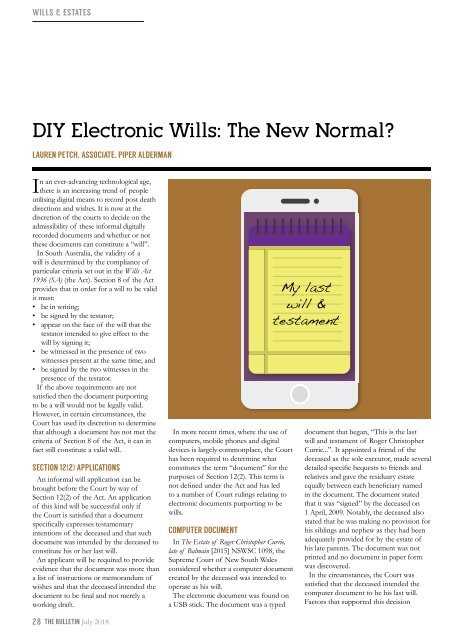LSB July 2018_Web
Create successful ePaper yourself
Turn your PDF publications into a flip-book with our unique Google optimized e-Paper software.
WILLS & ESTATES<br />
DIY Electronic Wills: The New Normal?<br />
LAUREN PETCH, ASSOCIATE, PIPER ALDERMAN<br />
In an ever-advancing technological age,<br />
there is an increasing trend of people<br />
utilising digital means to record post death<br />
directions and wishes. It is now at the<br />
discretion of the courts to decide on the<br />
admissibility of these informal digitally<br />
recorded documents and whether or not<br />
these documents can constitute a “will”.<br />
In South Australia, the validity of a<br />
will is determined by the compliance of<br />
particular criteria set out in the Wills Act<br />
1936 (SA) (the Act). Section 8 of the Act<br />
provides that in order for a will to be valid<br />
it must:<br />
• be in writing;<br />
• be signed by the testator;<br />
• appear on the face of the will that the<br />
testator intended to give effect to the<br />
will by signing it;<br />
• be witnessed in the presence of two<br />
witnesses present at the same time; and<br />
• be signed by the two witnesses in the<br />
presence of the testator.<br />
If the above requirements are not<br />
satisfied then the document purporting<br />
to be a will would not be legally valid.<br />
However, in certain circumstances, the<br />
Court has used its discretion to determine<br />
that although a document has not met the<br />
criteria of Section 8 of the Act, it can in<br />
fact still constitute a valid will.<br />
SECTION 12(2) APPLICATIONS<br />
An informal will application can be<br />
brought before the Court by way of<br />
Section 12(2) of the Act. An application<br />
of this kind will be successful only if<br />
the Court is satisfied that a document<br />
specifically expresses testamentary<br />
intentions of the deceased and that such<br />
document was intended by the deceased to<br />
constitute his or her last will.<br />
An applicant will be required to provide<br />
evidence that the document was more than<br />
a list of instructions or memorandum of<br />
wishes and that the deceased intended the<br />
document to be final and not merely a<br />
working draft.<br />
In more recent times, where the use of<br />
computers, mobile phones and digital<br />
devices is largely commonplace, the Court<br />
has been required to determine what<br />
constitutes the term “document” for the<br />
purposes of Section 12(2). This term is<br />
not defined under the Act and has led<br />
to a number of Court rulings relating to<br />
electronic documents purporting to be<br />
wills.<br />
COMPUTER DOCUMENT<br />
In The Estate of Roger Christopher Currie,<br />
late of Balmain [2015] NSWSC 1098, the<br />
Supreme Court of New South Wales<br />
considered whether a computer document<br />
created by the deceased was intended to<br />
operate as his will.<br />
The electronic document was found on<br />
a USB stick. The document was a typed<br />
My last<br />
will &<br />
testament<br />
document that began, “This is the last<br />
will and testament of Roger Christopher<br />
Currie...”. It appointed a friend of the<br />
deceased as the sole executor, made several<br />
detailed specific bequests to friends and<br />
relatives and gave the residuary estate<br />
equally between each beneficiary named<br />
in the document. The document stated<br />
that it was “signed” by the deceased on<br />
1 April, 2009. Notably, the deceased also<br />
stated that he was making no provision for<br />
his siblings and nephew as they had been<br />
adequately provided for by the estate of<br />
his late parents. The document was not<br />
printed and no document in paper form<br />
was discovered.<br />
In the circumstances, the Court was<br />
satisfied that the deceased intended the<br />
computer document to be his last will.<br />
Factors that supported this decision<br />
28 THE BULLETIN <strong>July</strong> <strong>2018</strong>


















